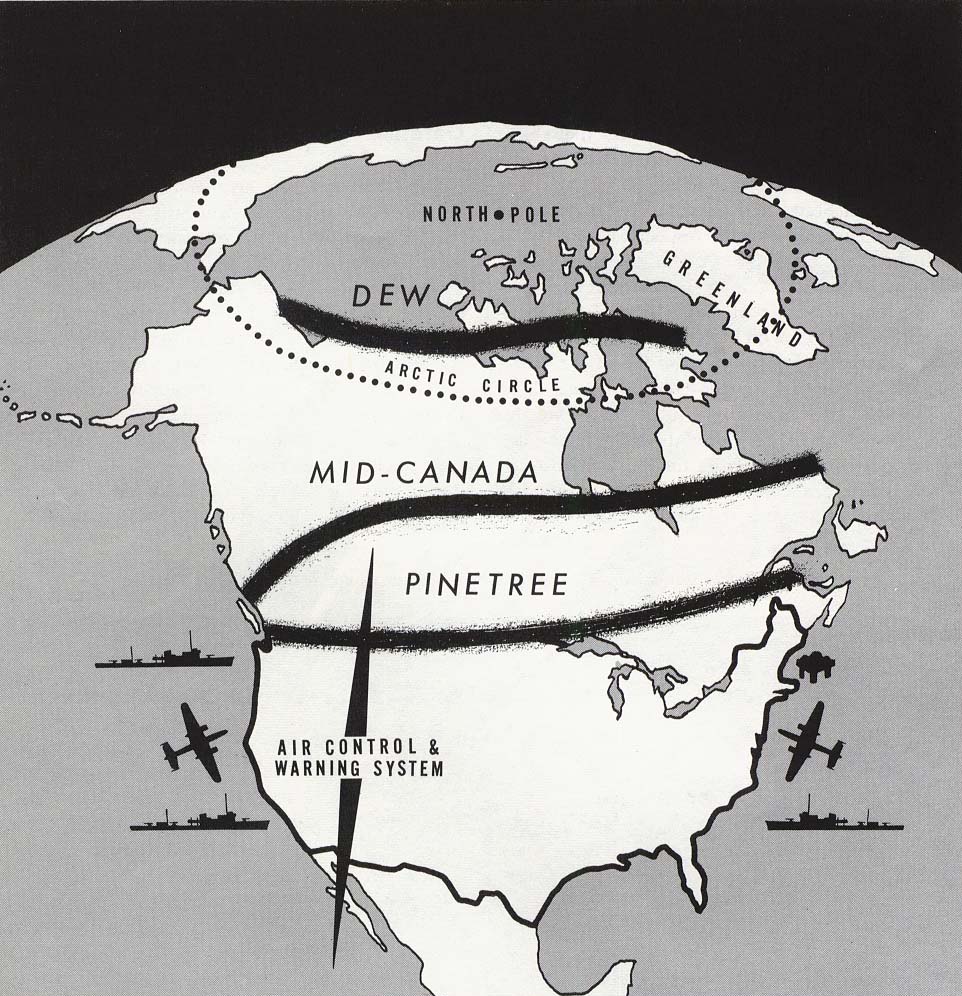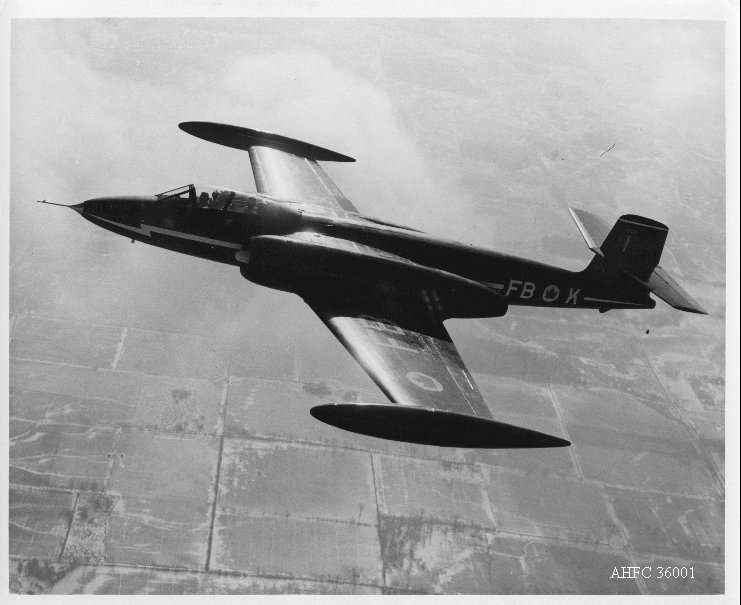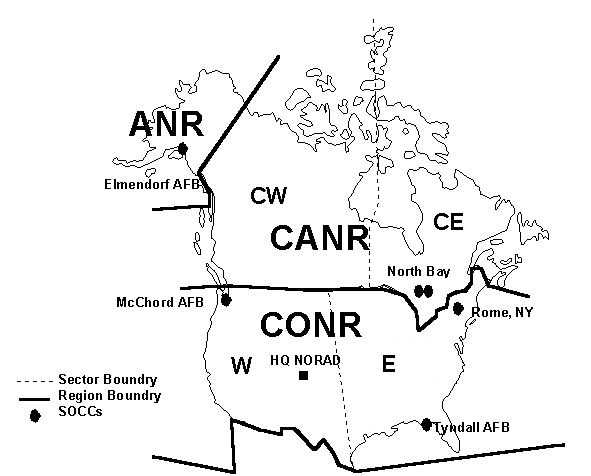|
CF-101
The McDonnell CF-101 Voodoo was an all-weather interceptor aircraft operated by the Royal Canadian Air Force and the Canadian Forces between 1961 and 1984. They were manufactured by the McDonnell Aircraft Corporation of St. Louis, Missouri for the United States Air Force (as F-101s), and later sold to Canada. CF-101s replaced the obsolete Avro CF-100 Canuck in the RCAF's all-weather fighter squadrons. The Voodoo's primary armament was nuclear AIR-2A Genie unguided air-to-air rockets, and there was significant political controversy in Canada about their adoption. Although they never fired a weapon in wartime, the CF-101 served as Canada's primary means of air defence from Quick Reaction Alert facilities at Canadian airbases. The CF-101s were retired in the 1980s and replaced with McDonnell Douglas CF-18 Hornet fighters. Many examples are preserved in museums and parks in Canada and the United States. Acquisition Origins After the cancellation of the CF-105 Arrow pro ... [...More Info...] [...Related Items...] OR: [Wikipedia] [Google] [Baidu] |
McDonnell F-101 Voodoo
The McDonnell F-101 Voodoo is a supersonic jet fighter which served the United States Air Force (USAF) and the Royal Canadian Air Force (RCAF). Initially designed by McDonnell Aircraft Corporation as a long-range bomber escort (known as a ''penetration fighter'') for the USAF's Strategic Air Command (SAC), the Voodoo was instead developed as a nuclear-armed fighter-bomber for the USAF's Tactical Air Command (TAC), and as a photo reconnaissance aircraft based on the same airframe. An F-101A set a number of world speed records for jet-powered aircraft, including fastest airspeed, attaining per hour on 12 December 1957. They operated in the reconnaissance role until 1979. Delays in the 1954 interceptor project led to demands for an interim interceptor aircraft design, a role that was eventually won by the B model of the Voodoo. This required extensive modifications to add a large radar to the nose of the aircraft, a second crew member to operate it, and a new weapons bay usin ... [...More Info...] [...Related Items...] OR: [Wikipedia] [Google] [Baidu] |
Canada And Weapons Of Mass Destruction
Canada has not officially maintained and possessed weapons of mass destruction since 1984 and, as of 1998, has signed treaties repudiating possession of them. Canada ratified the Geneva Protocol in 1930 and the Nuclear Non-proliferation Treaty in 1970. Nuclear weapons Introduction The first US nuclear weapon entered Canada in 1950 when the United States Air Force Strategic Air Command (SAC) stationed 11 model 1561 Fat Man atomic bombs at CFB Goose Bay, Newfoundland and Labrador. Goose Bay was used as an aircraft staging location for both the SAC and the Royal Air Force's V Force. The bombs were landed; crews relieved; aircraft refueled, or repaired; without returning to bases in the continental US. Nuclear weapons designs of the time were easily damaged but precise devices, that required off-aircraft inspection (after landing), and environmental sheltering (at a secure warm/dry location) while their carrier aircraft was on the ground for routine maintenance or repair. Fro ... [...More Info...] [...Related Items...] OR: [Wikipedia] [Google] [Baidu] |
AIR-2 Genie
The Douglas AIR-2 Genie (previous designation MB-1) was an unguided air-to-air rocket with a 1.5 kt W25 nuclear warhead. It was deployed by the United States Air Force (USAF 1957–1985) and Canada (Royal Canadian Air Force 1965–68, Air Command 1968–84) during the Cold War. Production ended in 1962 after over 3,000 were made, with some related training and test derivatives being produced later. Development The interception of Soviet strategic bombers was a major military preoccupation of the late 1940s and 1950s. The revelation in 1947 that the Soviet Union had produced a reverse-engineered copy of the Boeing B-29 Superfortress, the Tupolev Tu-4 (NATO reporting name "Bull"), which could reach the continental United States in a one-way attack, followed by the Soviets developing their own atomic bomb in 1949, produced considerable anxiety. The World War II-age fighter armament of machine guns and cannon were inadequate to stop attacks by massed formations of high-speed ... [...More Info...] [...Related Items...] OR: [Wikipedia] [Google] [Baidu] |
AIM-4 Falcon
The Hughes AIM-4 Falcon was the first operational guided air-to-air missile of the United States Air Force. Development began in 1946; the weapon was first tested in 1949. The missile entered service with the USAF in 1956. Produced in both heat-seeking and radar-guided versions, the missile served during the Vietnam War with USAF McDonnell Douglas F-4 Phantom II units. Designed to shoot down slow bombers with limited maneuverability, it was ineffective against maneuverable fighters over Vietnam. Lacking proximity fusing, the missile would only detonate if a direct hit was scored. Only five kills were recorded. With the AIM-4's poor kill record rendering the F-4 ineffective at air-to-air combat, the fighters were modified to carry the USN-designed AIM-9 Sidewinder missile instead, which was already carried on USN and USMC F-4 Phantom II and F-8 Crusader jet fighters. The Sidewinder was much more effective and improved versions continue to serve the armed forces of the United Stat ... [...More Info...] [...Related Items...] OR: [Wikipedia] [Google] [Baidu] |
McDonnell Douglas CF-18 Hornet
The McDonnell Douglas CF-18 Hornet (official military designation CF-188) is a Royal Canadian Air Force (RCAF) variant of the American McDonnell Douglas F/A-18 Hornet fighter aircraft. In 1980, the F/A-18 was selected as the winner of the New Fighter Aircraft Project competition and awarded a production order; deliveries of the CF-18 to the Canadian Armed Forces began in 1982. CF-18s have supported North American Aerospace Defense Command (NORAD) air sovereignty patrols and participated in combat during the Gulf War in 1991, the Kosovo War in the late 1990s, and as part of the Canadian contribution to the international Libyan no-fly zone in 2011. CF-18s were also part of the Canadian contribution to the military intervention against ISIL, Operation Impact. Development New Fighter Aircraft program In 1977, the Canadian government identified the need to replace the NATO-assigned CF-104 Starfighter, the NORAD-assigned CF-101 Voodoo and the CF-116 Freedom Fighter (although the de ... [...More Info...] [...Related Items...] OR: [Wikipedia] [Google] [Baidu] |
CFB Uplands
Canadian Forces Base Uplands (also CFB Uplands) was a Canadian Forces Base located in Ottawa, Ontario. Most of the land which formed the base was transferred to the Ottawa Macdonald–Cartier International Airport after the base was closed in the 1990s. Several military units continue to exist at the former base and the Canadian Forces continues to maintain military housing at the site. The former base is now known formally as "Canadian Forces Support Unit (Ottawa) - Uplands Site." History The Royal Canadian Air Force established RCAF Station Uplands as a wartime training station of the British Commonwealth Air Training Plan in 1942. The "No. 2 Service Flying Training School" (SFTS) was located at the base from August 1942 to April 1947, which was one of two RCAF facilities in the national capital region; the other was RCAF Station Rockcliffe. When Sabre fighters became operational in 1952, Uplands became the primary Ottawa air base since Sabres couldn't operate from the small ... [...More Info...] [...Related Items...] OR: [Wikipedia] [Google] [Baidu] |
RCAF CF-101B Voodoo
The Royal Canadian Air Force (RCAF; french: Aviation royale canadienne, ARC) is the air and space force of Canada. Its role is to "provide the Canadian Forces with relevant, responsive and effective airpower". The RCAF is one of three environmental commands within the unified Canadian Armed Forces. As of 2020, the Royal Canadian Air Force consists of 12,074 Regular Force and 1,969 Primary Reserve personnel, supported by 1,518 civilians, and operates 258 manned aircraft and nine unmanned aerial vehicles. Lieutenant-General Eric Kenny is the current commander of the Royal Canadian Air Force and chief of the Air Force Staff. The Royal Canadian Air Force is responsible for all aircraft operations of the Canadian Forces, enforcing the security of Canada's airspace and providing aircraft to support the missions of the Royal Canadian Navy and the Canadian Army. The RCAF is a partner with the United States Air Force in protecting continental airspace under the North American Aerospa ... [...More Info...] [...Related Items...] OR: [Wikipedia] [Google] [Baidu] |
Royal Canadian Air Force
The Royal Canadian Air Force (RCAF; french: Aviation royale canadienne, ARC) is the air and space force of Canada. Its role is to "provide the Canadian Forces with relevant, responsive and effective airpower". The RCAF is one of three environmental commands within the unified Canadian Armed Forces. As of 2020, the Royal Canadian Air Force consists of 12,074 Regular Force and 1,969 Primary Reserve personnel, supported by 1,518 civilians, and operates 258 manned aircraft and nine unmanned aerial vehicles. Lieutenant-General Eric Kenny is the current commander of the Royal Canadian Air Force and chief of the Air Force Staff. The Royal Canadian Air Force is responsible for all aircraft operations of the Canadian Forces, enforcing the security of Canada's airspace and providing aircraft to support the missions of the Royal Canadian Navy and the Canadian Army. The RCAF is a partner with the United States Air Force in protecting continental airspace under the North American Aerospac ... [...More Info...] [...Related Items...] OR: [Wikipedia] [Google] [Baidu] |
Avro Canada CF-105 Arrow
The Avro Canada CF-105 Arrow was a delta-winged interceptor aircraft designed and built by Avro Canada. The CF-105 held the promise of Mach 2 speeds at altitudes exceeding and was intended to serve as the Royal Canadian Air Force's (RCAF) primary interceptor into the 1960s and beyond. The Arrow was the culmination of a series of design studies begun in 1953 that examined improved versions of the Avro Canada CF-100 Canuck. After considerable study, the RCAF selected a dramatically more powerful design, and serious development began in March 1955. The aircraft was intended to be built directly from the production line, skipping the traditional hand-built prototype phase. The first Arrow Mk. 1, RL-201, was rolled out to the public on 4 October 1957, the same day as the launch of Sputnik I. Flight testing began with RL-201 on 25 March 1958, and the design quickly demonstrated excellent handling and overall performance, reaching Mach 1.9 in level flight. Powered by the Pratt & ... [...More Info...] [...Related Items...] OR: [Wikipedia] [Google] [Baidu] |
Avro CF-100 Canuck
The Avro Canada CF-100 Canuck (affectionately known as the "Clunk") is a Canadian twinjet interceptor/ fighter designed and produced by aircraft manufacturer Avro Canada. It has the distinction of being the only Canadian-designed fighter to enter mass production. Work commenced during October 1946 in response to a Royal Canadian Air Force (RCAF) specification calling for a new jet-powered interceptor/fighter aircraft suitable for long-distance patrol missions and all-weather operations. On 19 January 1950, the ''CF-100 Mark 1'' prototype, ''18101'', conducted its maiden flight, powered by a pair of Rolls-Royce Avon RA 3 turbojet engines. Both pre-production and production series aircraft were powered by the domestically-developed Avro Orenda engine instead. Flight testing proved the CF-100 to possess a relatively short takeoff run and a high climb rate, making it well suited to its role as an interceptor. On 18 December 1952, Squadron Leader Janusz Żurakowski, the Avro compa ... [...More Info...] [...Related Items...] OR: [Wikipedia] [Google] [Baidu] |
North American Aerospace Defense Command
North American Aerospace Defense Command (NORAD ), known until March 1981 as the North American Air Defense Command, is a combined organization of the United States and Canada that provides aerospace warning, air sovereignty, and protection for Canada and the continental United States. Headquarters for NORAD and the NORAD/ United States Northern Command (USNORTHCOM) center are located at Peterson Space Force Base in El Paso County, near Colorado Springs, Colorado. The nearby Cheyenne Mountain Complex has the Alternate Command Center. The NORAD commander and deputy commander (CINCNORAD) are, respectively, a United States four-star general or equivalent and a Canadian lieutenant-general or equivalent. Organization CINCNORAD maintains the NORAD headquarters at Peterson Space Force Base near Colorado Springs, Colorado. The NORAD and USNORTHCOM Command Center at Peterson SFB serves as a central collection and coordination facility for a worldwide system of sensors desig ... [...More Info...] [...Related Items...] OR: [Wikipedia] [Google] [Baidu] |
John Diefenbaker
John George Diefenbaker ( ; September 18, 1895 – August 16, 1979) was the 13th prime minister of Canada, serving from 1957 to 1963. He was the only Progressive Conservative party leader between 1930 and 1979 to lead the party to an election victory, doing so three times, although only once with a majority of the seats in the House of Commons. Diefenbaker was born in southwestern Ontario in the small town of Neustadt in 1895. In 1903, his family migrated west to the portion of the North-West Territories which would soon become the province of Saskatchewan. He grew up in the province and was interested in politics from a young age. After service in World War I, Diefenbaker became a noted criminal defence lawyer. He contested elections through the 1920s and 1930s with little success until he was finally elected to the House of Commons in 1940. Diefenbaker was repeatedly a candidate for the party leadership. He gained that position in 1956, on his third attempt. In 1957, ... [...More Info...] [...Related Items...] OR: [Wikipedia] [Google] [Baidu] |









